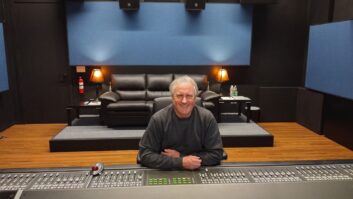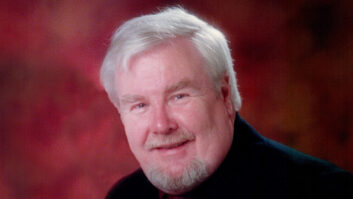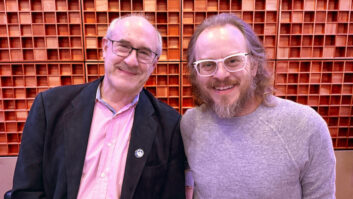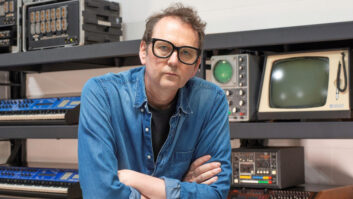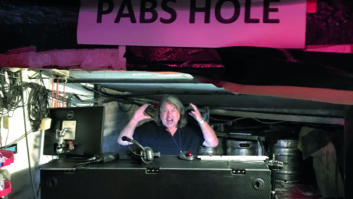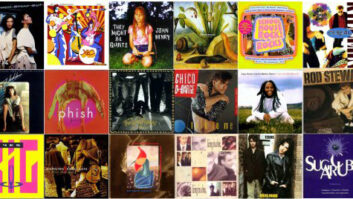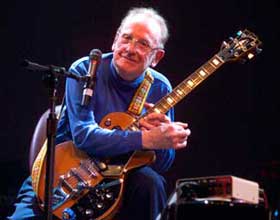
HAVE A LES PAUL MEMORY? GREAT PHOTO? E-Mail Us at [email protected]
Les Paul, acclaimed guitar player, entertainer and inventor, passed away today from complications of severe pneumonia at White Plains Hospital in White Plains, NY, surrounded by family and loved ones. He was 94.
With his development of multitrack recording techniques and inventions such as the solid body electric guitar, Les was a major influence nearly every aspect of modern music production technology and performance, in addition to being one of America’s most popular, influential, and accomplished electric guitarists.
“The world has lost a truly innovative and exceptional human being today. I cannot imagine life without Les Paul. He would walk into a room and put a smile on anyone’s face. His musical charm was extraordinary and his techniques unmatched anywhere in the world,” said Henry Juszkiewicz, Chairman and CEO of Gibson Guitar. “We will dedicate ourselves to preserving Les’ legacy to insure that it lives on forever. He touched so many lives throughout his remarkable life and his influence extends around the globe and across every boundary. I have lost a dear, personal friend and mentor, a man who has changed so many of our lives for the better.”
Born Lester William Polsfuss in Waukesha, Wisconsin on June 9, 1915, Les began performing publicly as a honky-tonk guitarist by the age of 13 and he dropped out of high school at 17 to play in Sunny Joe Wolverton’s Radio Band in St. Louis. As Paul’s mentor, Wolverton christened him with the stage name “Rhubarb Red,” a moniker that would follow him to Chicago in 1934. There, Paul became a bonafide radio star, known as both hillbilly picker Rhubarb Red and jazz guitarist Les Paul. The next year he formed his first trio, but by 1938 he’d moved to New York to begin his tenure on national radio with one of the more popular dance orchestras in the country, Fred Waring’s Pennsylvanians.
” />

Les Paul’s famous “The Log” solidbody guitar (made from a 4×4) with detachable wings
Tinkering with electronics and guitar amplification since his youth, Les Paul began constructing his own electric guitar in the late ’30s. “I was interested in proving that a vibration-free top was the way to go,” he said. “I even built a guitar out of a railroad rail to prove it. I wanted to amplify pure string vibration, without the resonance of the wood getting involved in the sound.” With the good graces of Epiphone president Epi Stathopoulo, Paul used the Epiphone plant and machinery in 1941 to bring his vision to fruition. He affectionately dubbed the guitar “The Log.”
Les, The Experimenter
Les Paul’s tireless experiments sometimes proved to be dangerous, and he nearly electrocuted himself in 1940 during a session in the cellar of his Queens apartment. During the next two years of rehabilitation, Les earned his living producing radio music and later moved to Hollywood. During World War II, he was drafted into the Army but permitted to stay in California, playing for Armed Forces Radio Service. By 1943 he had assembled a trio that regularly performed live, on the radio, and on V-Discs. His novelty instrumentals were tighter, brasher, and punctuated with effects. Overall, the trademark Les Paul sound was razor-sharp, clean-shaven, and divinely smooth.
As small combos eclipsed big bands toward the end of World War II, Les Paul Trio’s popularity grew. They cut records for Decca both alone and behind the likes of Helen Forrest, the Andrews Sisters, the Delta Rhythm Boys, Dick Hayes, and, most notably, Bing Crosby. Since 1945, when the crooner brought them into the studio to back him on a few numbers, the Trio had become regular guests on Crosby’s hit radio show. The highlight of the session was Paul’s first No. 1 hit and million-seller, the gorgeous “It’s Been a Long, Long Time.”
Meanwhile, Paul began to experiment with dubbing live tracks over recorded tracks, also altering the playback speed. This resulted in “Lover (When You’re Near Me),” his revolutionary 1947 predecessor to multitrack recording. The hit instrumental featured Les Paul on eight different electric guitar parts. In 1948, Paul was nearly killed in a devastating car crash that shattered his right arm and elbow. He convinced doctors to set his broken arm in the guitar-picking and cradling position. Laid up but undaunted, Paul acquired a first generation Ampex tape recorder from Crosby in 1949, and began his most important multitracking adventure, adding a fourth head to the recorder to create sound-on-sound recordings. While tinkering with the machine and its many possibilities, he also came up with tape delay.

Les the experimenter in his studio in 1950.
These tricks, along with another recent Les Paul innovation—close-miked vocals—were integrated for the first time on a single recording: the 1950 No. 1 tour de force “How High the Moon.” This historic track was performed during a duo with future wife Mary Ford. The couple’s prolific string of hits for Capitol Records not only included some of the most popular recordings of the early 1950s, but also wrote the book on contemporary studio production. The dense but crystal-clear harmonic layering of guitars and vocals, along with Ford’s close-miked voice and Paul’s guitar effects, produced distinctively contemporary recordings with unprecedented sonic qualities.
All the while, Les Paul continued to pine for the perfect guitar. Though The Log came close, it wasn’t quite what he was after. In the early 1950s, Gibson Guitar would cultivate a partnership with Paul that would lead to the creation of the guitar he’d seen only in his dreams. Gibson avidly courted the guitar legend, even driving deep into the Pennsylvania mountains to deliver the first model to newlyweds Les Paul and Mary Ford. “Les played it, and his eyes lighted up,” then-Gibson President Ted McCarty once recalled. Paul signed on as the namesake of Gibson’s first electric solidbody, with exclusive design privileges. Working closely with Paul, Gibson forged a relationship that would change popular culture forever.
The Multitrack Revolution
The impetus for multitracking came from Paul, who modified a tape deck with an extra head and a switch to defeat the erase function and was doing sound-on-sound recording as early as 1949. However, the technique was risky: One bad pass and the recording was ruined, and each additional pass added noise and distortion.
With the concept for an 8-track in mind, Paul met with the special modifications team at Ampex, which started the project in 1953. To succeed, the task required designing new record/play and erase heads, and the difficult switching of very low-level/high-impedance circuitry to achieve exact sync in monitoring previous tracks while overdubbing new ones. Ampex engineer Mort Fujii felt it could be done, and the first 1-inch Sel-Sync 8-track (based on an instrumentation deck) went to Paul two years later for $10,000—a sum that could have bought two nice houses at the time!

Les lays down a hot solo at NYC’s Iridium Club.
Les Paul has since become the only individual to share membership into the Grammy Hall of Fame, the Rock and Roll Hall of Fame, the National Inventors Hall of Fame, and the National Broadcasters Hall of Fame. Les is survived by his three sons Lester (Rus) G. Paul, Gene W. Paul and Robert (Bobby) R. Paul, his daughter Colleen Wess, son-in-law Gary Wess, long time friend Arlene Palmer, five grandchildren and five great grandchildren.
A private Funeral service will be held in New York. A service in Waukesha, WI will be announced at a later date. Details will follow and will be announced for all services. Memorial tributes for the public will be announced at a future date. The family asks that in lieu of flowers, donations be made to the Les Paul Foundation, 236 West 30th Street, 7th Floor, New York, New York 10001.
